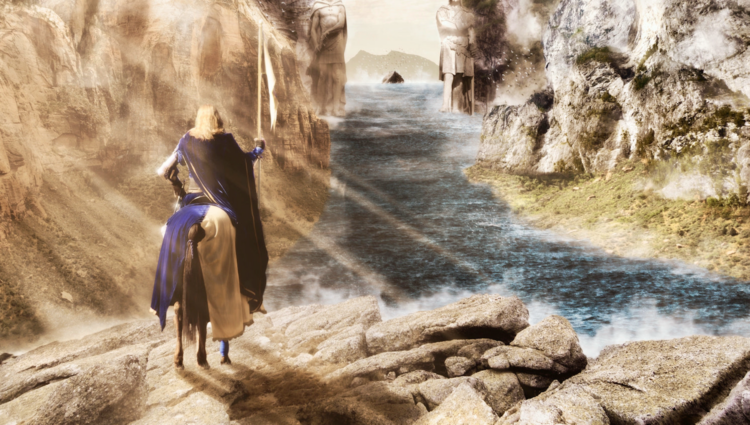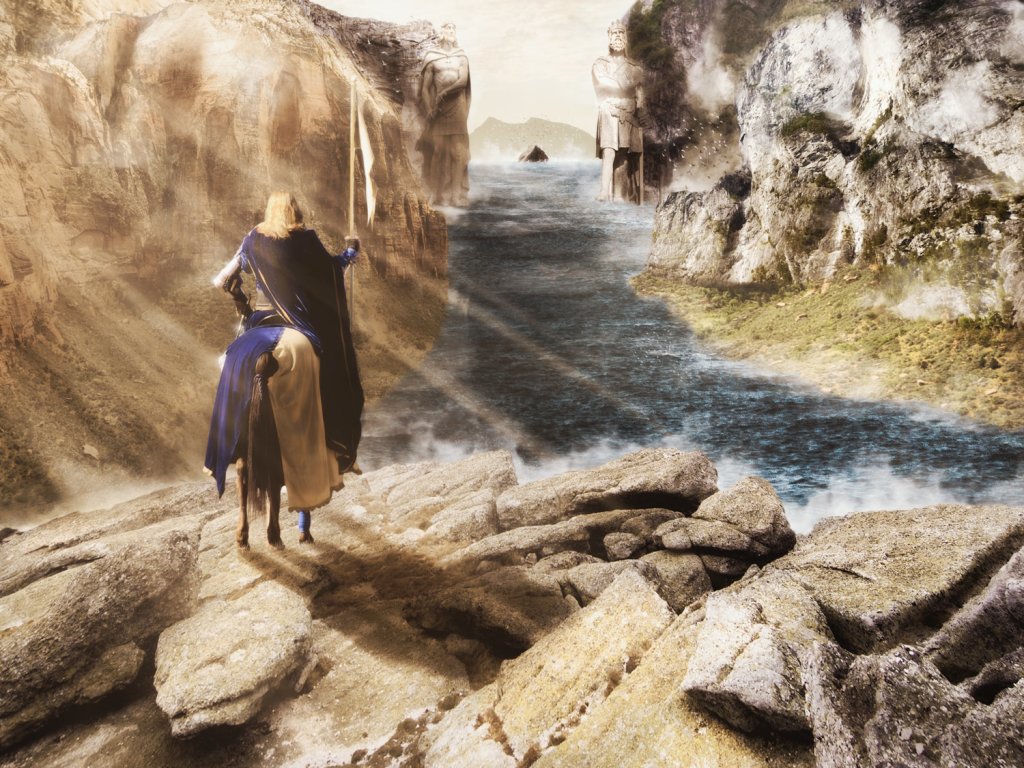“The Lord of the Rings” is not an allegorical story, nor should it be treated as such, but that does not mean that the story cannot be used to contemplate and plumb the depths of humanity and its relation to the divine.
That J.R.R. Tolkien had a great dislike for his works being called “allegories” needs little, if any, argument. Such sentiments abound in his letters. Yet one distinction that Tolkien makes several times in his letters when he addresses allegory is often overlooked, and that is “applicability.”
“There is no ‘symbolism’ or conscious allegory in my story,” Tolkien writes. “That there is no allegory does not, of course, say there is no applicability. There always is…. but I should say, if asked, the tale is not really about Power and Dominion: that only sets the wheels going; it is about Death and the desire for deathlessness. Which is hardly more than to say it is a tale written by a Man!” (Tolkien, Letters 203)
It is this ‘applicability’ that permits his readers to see the characters of Gandalf, Frodo, and Aragorn as emblematic of, but not allegories for, the roles of prophet, priest, and king, which each child of God is called to fill; there is a certain level at which, through stories, we contemplate our own humanity and even our role in relation to the divine. As Tolkien himself states, The Lord of the Rings is ultimately about Death and man’s desire for deathlessness. That is to say, it is about a particular aspect of man’s relationship to the world, the mortal end of that relationship, and the mystery of what follows–in other words, our relation to the divine.
While this contemplation of Death can be linked to Tolkien’s scholarly views of Beowulf as an elegiac work, the specific depiction and outcome of his meditation on Death in The Lord of the Rings reveals something grander than a repetition of an Anglo-Saxon epic poem. It reveals one of the ways in which this story is a fundamentally Catholic work, for as Tolkien reveals through several key passages in the third volume, Return of the King, the contemplation of his story is not about the Victory of Death—about the claim it has on all mortal men no matter how vicious or heroic, as in Beowulf—but the Defeat of Death.
The Battle of The Pelennor Fields, the passing of Sauron and the demise of his Dark Tower Barad-dur, and the Crowning of the King all joyously acclaim this defeat, this wondrous triumph of good over evil which is none other than the Eucatastrophic Joy of Easter. With the miraculous appearance of the Rohirrim in the hour of Gondor’s despair, appearing with the cock’s crowing and the coming of the dawn (Tolkien, Lord of the Rings 829), Tolkien first hints at this Easter Joy, for “morning came, morning and a wind from the sea; and darkness was removed, and the hosts of Mordor wailed, and terror took them, and they fled, and died, and the hoofs of wrath rode over them” (Tolkien, Lord of the Rings 838).
Yet though these glimpses of joy appear throughout this final volume of the story, particularly with Aragorn’s works of healing in Minas Tirith, it is not truly until the Ring is destroyed and the hosts of the West gather in the Field of Cormallen that Tolkien unveils the Easter Joy thathis story contemplates, starting, fittingly, with Sam saying “Gandalf! I thought you were dead! But then I thought I was dead myself. Is everything sad going to come untrue? What’s happened to the world?” (Tolkien, Lord of the Rings 951). So the mystery of Death’s defeat first truly appears, for something miraculous has happened to the world, something that has made the sadness of Death untrue. This feeling of wonder and joy continues to well up in Sam, so that Gandalf’s laughter “fell upon his ears like the echo of all the joys he had ever known. But he himself burst into tears”, and so that he “feel[s] like spring after winter, and sun on the leaves; and like trumpets and harps and all the songs I have ever heard!” (Tolkien Lord of the Rings 952). Indeed, how else can we respond to the mystery of Death’s Defeat than first with tears, then with joy? Here with Sam, then, is the first true tiding of Easter Joy.
Yet it is far from the last. As Gandalf informs Sam and Frodo, “in Gondor the New Year will always now begin upon the twenty-fifth of March when Sauron fell, and when you were brought out of the fire to the King. He has tended you, and now he awaits you. You shall eat and drink with him” (952). The date of March 25 is, in several very old Catholic traditions dating back to even before St. Augustine’s time, the exact date of Christ’s Crucifixion; it is also the date of his conception, the Solemnity of the Annunciation. Tolkien’s choice of this date for the defeat of Sauron is far from coincidental, as T.A. Shippey has already argued, somewhat contemptuously, in his Road to Middle-Earth (Shippey, Road to Middle-Earth 151-2). Shippey dismissively states that Tolkien used the date to turn the ‘eucatastrophe’ of his story into a “forerunner or ‘type’ of the greater one of Christian myth” (Shippey, Road to Middle-Earth 152). While strictly true, it is a far cry from the whole truth. Tolkien’s use of the date is not some artificial mechanism by which he links his tale to the Christian myth to come, but a deliberate placement of his tale in history, and not just history, but salvation history, making his story not an allegory for the Resurrection but a moment in time and myth which prefigures that highest joy, by participating in and reflecting upon that same grief and joy, which is the Death and Resurrection.
Nor is the use of the date the only part of Gandalf’s quotation that reflects the Joy of Easter, for the Wizard’s description of Frodo and Sam as having come out of fire to the King to feast with him also reflects the salvation of souls from damnation and their entrance into the Heavenly Kingdom, where they shall rest and feast with the King of Kings who has by his victory “taken back all his ancient realm,” the fallen earth (Tolkien, Lord of the Rings 952).
The tears and joy of Frodo and Sam and the hosts of the West all speak to this Easter Joy, which Tolkien here contemplates through the defeat of Sauron, but there is one final significant moment that reflects this Easter Joy, and that is when the news of Victory comes to the city of Gondor. There even before the Eagle bears the glad tidings, everyone senses first the doom, then the Victory, for “the Shadow departed, and the Sun was unveiled, and light leaped forth… and in all the houses of the City men sang for the joy that welled up in their hearts from what source they could not tell” (Tolkien Lord of the Rings 963). And even as they begin to sing and celebrate, an Eagle confirms their joy, telling them “the Black Gate is broken, / and your King hath passed through, / and he is victorious…your King shall come again, / and he shall dwell among you / all the days of your life” (Tolkien Lord of the Rings 963). In this cry of the herald eagle again the Joy of Easter soars, for the messenger’s announcement, in speaking of the gates that the King has broken and passed through, reflects the Harrowing of Hell and the joy of that great triumph, all while affirming that the King shall return to his City to dwell with his people forever.
These instances are not mere allegory, for Aragorn truly is his own character and not simply Jesus Christ in allegory; yet he is the King. And he has returned from the Harrowing of a hellish land to dwell once more among his people. Similarly, the sorrow for the great grief and suffering that all have endured at the hands of Sauron, and the tears of joy and laughter for his final defeat are not an allegory for the sting of Death and Sin, yet they are a grief and joy sprung from the Shadow and its passing.
The Lord of the Rings is not an allegorical story, nor should it be treated as such, but that does not mean that the story cannot be used to contemplate and plumb the depths of humanity and its relation to the divine. The event of the Resurrection is an event that transcends time; it is far from implausible that a man such as Tolkien, who argued that myth and fantasy breach through time into joyful glimpses of eternity, would use his own stories as a shadowy remembrance, past or future, of that eternal, transcendent moment… allegory be damned. As Tolkien himself said, while his story is about the actions of specific characters in a far-off time, it is largely about Death. Why on Middle-Earth would that mean that it cannot be about the Triumph over Death?
This essay was first published here in April 2022.
The Imaginative Conservative applies the principle of appreciation to the discussion of culture and politics—we approach dialogue with magnanimity rather than with mere civility. Will you help us remain a refreshing oasis in the increasingly contentious arena of modern discourse? Please consider donating now.
The featured image, uploaded by Jmproaud, is “The Argonath And The Falls Of Rauros.” This file is licensed under the Creative Commons Attribution 3.0 Unported license.courtesy of Wikimedia Commons.



